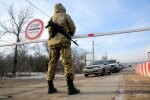
Выступление Юрия Романенко перед иностранными дипломатами и экспертами в литовском посольстве 8 февраля 2016 года, где были рассмотрены базовые сценарии развития ситуации в Украине.
Dear ladies and gentlemen, our forum is taking place against the backdrop of a corruption scandal connected with Igor Kononenko, and it perfectly illustrates my assumption that in 2016-2017 we will see the final crisis of the Second Ukrainian Republic. This crisis is linked to the total depletion of the resource base of the existing model of statehood of Ukraine since 1991.
Firstly, we are witnessing a dramatic drop of confidence in all state institutions.
Second, the global crisis has worsened the conjuncture for Ukrainian exports, and this led to a sharp drop in the export of our major industries and the domestic market has also continued to fall.
Third, social inequality is deepening, which enhances the conflicts between different social groups.
Fourth, we witness the ongoing conflict of the old elites, which does not allow the situation to stabilize.
Fifth, we have a war with Russia, which itself falls into increasingly deep crisis, trying to shift its costs to Ukraine and Europe.
Thus, we have a classic revolutionary situation: the upper classes are not able, lower classes do not want.
In these circumstances, I see three scenarios for the development of the situation in Ukraine and they are observed in the Middle East.
The first scenario — the Syrian, it is the war of all against all.
This scenario has the following premises:
a) the presence of opposing social groups whose interests and values are antagonistic, the war in Donbas sharply intensified these contradictions;
Украинцев развернут на границе с Польшей: все из-за документов и денег
Рынок аренды жилья перевернулся: украинцы бегут из больших городов
ВЛК в Резерв+: для военнообязанных изменили правила фиксации медосмотров
Касается всех украинцев: эта купюра вскоре исчезнет
b) the existence of regional disparities, which will intensify if the Donbas will receive broad autonomy;
c) the center can hardly control the regions, which depend on local elites. They remain loyal to Kiev as long as Kiev respects their power and does not violate the status quo (a vivid example — Transcarpathian region)
g) the weakness of the security forces, and as a consequence — the lack of the state’s monopoly on violence.
e) The factor of Russia, which is now trying to preserve the uncertainty of Ukraine through the implementation of the Minsk-2.
In this scenario Ukraine de facto becomes a confederation with a weak center and strong regions like in Bosnia. In this case, a formal statehood and puppet leadership in Kiev will be recognized by external actors, but de facto Kiev will have no real influence and power will pass into the hands of regional warlords and other actors who control the territories. Thus, the Ukrainian issue will be addressed by external players, as it happened during the civil war of 1917-1920. And we shall probably lose another significant part of the territory.
The second scenario — the Egyptian, which can be implemented in the form of revolutionary or counter-revolutionary coup.
This case can become possible in several ways:
a) Conservative (counterrevolutionary) — for example, if the incumbent president or other oligarchic groups will be able to take control of the power vertical and use a repressive apparatus to establish control over the country, as General Sisi.
b) A revolutionary — when a group of revolutionaries led by a new elite, or a bunch of old and new elites will attempt to seize the power to realize the modernization of Ukraine in the forced mode.
This scenario can be successfully implemented if the group has sufficient power resource to take control of the regions quickly. A very important factor will be to achieve the loyalty of regional elites, either through their fear of repressions, or through the implementation of their interest. The most important factor is the support of the West, which legitimizes the new regime and maintains its resources in the first stage. Final important factor is high internal legitimacy of the regime to the community, which should support such action, so, it needs to rely on one or two popular political forces with charismatic leaders and coherent agenda involving the basic social groups.
If the coup is conservative, as in Egypt, then the main goals of the revolution will not be achieved and the situation at any time can get out of control, which could result in the first scenario that is a civil war with foreign intervention elements, a gray zone, a weak confederation under external management.
However, if the revolutionary version of the coup is successful, the way out of the crisis will be accelerated by the annihilation of several old oligarchic groups.
Who is able to realize it: an alliance of new and partly old elites plus members of army top brass, volunteers, security services, plus the urban middle class of large and medium cities. Yes, it is quite possible we lose some other regions.
A historical example: Ataturk is coming to power establishing the Turkish Republic in 1919-1922.
The third scenario — a Tunisian, a scenario of political consensus when structured social groups create a new elite and come to agreement on the new rules with a part of the old elite.
If the old elite (or any part of it, logically, at least half) accepts such conditions it creates an opportunity for peaceful transition to a new structure of the state — the third Ukrainian Republic. In such circumstances, the new political regime offers a quiet retreat from power to the old elite, ensures rules and property rights. The technocratic government removes the key imbalances in the political system and the economy, including decentralization.
A key element in this design is the ability of the new elite to perform the functions of the arbitrator. Arbitration will bring it into a superposition, because the old elite and society would be afraid of the conflicts that tore the Second Ukrainian Republic.
This scenario requires the launch of the Constitutional Convention to adopt a new Constitution, which will be in fact a new social contract.
As historical examples, in addition to the recent stabilization in Tunisia in 2013, we can recall the revival of the Third Rzeczpospolita on the ruins of the Polish People’s Republic in 1989-1990.
Today all three scenarios in Ukraine are equally probable. They all have more or less the same chances in the current environment.
Their simultaneous implementation is also quite possible in different regions of the country: for example, one region follows Donetsk or Luhansk People Republics, some regional elites take control of the situation and make a revolution, and some reach political consensus and pull together all the advanced and progressive forces.
At the same time we need to understand that these scenarios, in particular the timing and shape of their implementation, will be actively influenced by Russia, which will push the first Syrian or the counterrevolutionary Egyptian scenario. The success of the third scenario will depend not only on the negotiability of our political elites, but also on how quickly Russia will deepen in its problems. Many foreign experts, including Russians believe that Russia’s margin of safety is up to two years maximum, and the Kremlin will use this time to swing the situation in Ukraine and in Europe.
Thus, the positive prospects of Ukraine are directly proportional to its stability during these critical two years and will grow while Russia will be weakening from the end of 2016-2017.
To sum up: I believe that we shall spend 2 years to break the system and 3 more years for macro stabilization. So, Ukraine’s stabilization will happen by 2020.




























